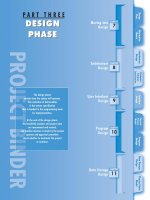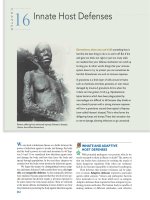Ebook Surgical tips and skills (1st edition): Part 2
Bạn đang xem bản rút gọn của tài liệu. Xem và tải ngay bản đầy đủ của tài liệu tại đây (49.64 MB, 185 trang )
ADVANCED
1/3
Closure of dorsal hand defect (KPIF) – case series no. 8
INTRAOPERATIVE
Introduction
The problem of a skin tumour on the
dorsum of the hand can usually be solved
with multiple local or locoregional flaps
when grafting is inappropriate (e.g. over
exposed tendons). The keystone island flap
is designed on the side of the lesion where
the ‘pinch test’ indicates maximum tissue
laxity. (see Figure 2). Such flaps are based
on ad hoc metacarpal perforators from the
distal palmar arch and tensional closure
allows ready apposition.
Problem
Figure 1: SCC on the dorsum
of the (L) hand. Mark-out of
the KPIF along the
embryological C7 dermatome
Notes _____________________
___________________________
___________________________
___________________________
___________________________
___________________________
___________________________
___________________________
Solution
SURGICAL TIPS AND SKILLS
Figure 2: The pinch test for
skin laxity. The keystone is best
designed along the ulnar side
of the defect. Placement on
the radial side entails
enlargement into the cleft over
the first dorsal interosseous
muscle, which becomes too
tight
Notes _____________________
___________________________
___________________________
___________________________
___________________________
142
___________________________
ADVANCED
Closure of dorsal hand defect (KPIF) – case series no. 8
Notes _____________________
___________________________
___________________________
INTRAOPERATIVE
Figure 3: The flap is raised,
supported by what appears
to be only diaphanous
neurovascular structures.
Such thinness is not a
contraindication for its use at
this site
2/3
___________________________
___________________________
___________________________
Figure 4: Closure with V–Y
apposition with drainage. The
mark-out shows the course of
the radial cutaneous nerve,
which has been preserved
Notes _____________________
___________________________
___________________________
___________________________
___________________________
___________________________
___________________________
Figure 5: Release of the
tourniquet showing the
paradoxical hyperaemia (PH)
Notes _____________________
___________________________
___________________________
___________________________
___________________________
___________________________
___________________________
SURGICAL TIPS AND SKILLS
___________________________
___________________________
___________________________
143
ADVANCED
3/3
Closure of dorsal hand defect (KPIF) – case series no. 8
INTRAOPERATIVE
Outcome
Figure 6: Appearance at 1
week
Notes _____________________
___________________________
___________________________
___________________________
___________________________
___________________________
___________________________
___________________________
___________________________
Figure 7: Appearance at 6
months – an acceptable
aesthetic outcome, which has
been pain-free throughout.
The patient is back to playing
golf and regards his hand as
totally normal
Notes _____________________
___________________________
___________________________
___________________________
___________________________
___________________________
___________________________
SURGICAL TIPS AND SKILLS
144
ADVANCED
Delayed facial nerve neuropraxia following SCC excision
– McLaughlin tarsorrhaphy – case series no. 9
Introduction
In head and neck reconstruction, KPIF
closure of large defects of the cheek in
which the facial nerve has been sacrificed
to achieve oncological clearance, the
tightness of the closure obviates the need
for immediate facial nerve reconstruction
with or without static or dynamic repair,
including tarsorrhaphy.
Problem
Figure 1: Prior wide excision
(8 × 6 cm) of a (R) parotid
SCC with node clearance (II, III
and IV). The periosteal strip of
the (R) mandible completed
the procedure and the defect
was closed by a KPIF followed
by XRT. Some months later the
patient re-presented in need of
a (R) tarsorraphy. Incidentally,
another keratinising lesion
developed on the upper lip in
the interval
INTRAOPERATIVE
Duet procedure done in association with
Professor Andrew Sizeland.
1/3
Notes _____________________
___________________________
Solution
Figure 2: McLaughlin
tarsorrhaphy technique: the
triangulate de-epithelialisation
of the lower eyelid is matched
with de-mucosalising of the
upper eyelid in a matching
triangulate fashion
Notes _____________________
___________________________
___________________________
___________________________
___________________________
___________________________
SURGICAL TIPS AND SKILLS
___________________________
145
ADVANCED
2/3
Delayed facial nerve neuropraxia following SCC excision – McLaughlin
tarsorrhaphy – case series no. 9
INTRAOPERATIVE
Figure 3: The angles at the
apices of the symmetrical
triangle design are sutured
with 4-0 nylon with tubing
protection and left in situ for
3 weeks
Notes _____________________
___________________________
___________________________
___________________________
___________________________
___________________________
___________________________
Figure 4: The appearance on
completion
Notes _____________________
___________________________
___________________________
___________________________
___________________________
___________________________
___________________________
SURGICAL TIPS AND SKILLS
146
___________________________
___________________________
___________________________
ADVANCED
Delayed facial nerve neuropraxia following SCC excision – McLaughlin
tarsorrhaphy – case series no. 9
Figure 5: Postoperative image
showing the closure protecting
the exposed pupil
Notes _____________________
___________________________
___________________________
___________________________
___________________________
INTRAOPERATIVE
Outcome
3/3
___________________________
___________________________
___________________________
___________________________
___________________________
Approximately 35-minute procedure. Return
of total comfort without complication.
SURGICAL TIPS AND SKILLS
147
ADVANCED
1/4
DRAPE procedure as salvage for recurrent disease –
case series no. 10
INTRAOPERATIVE
Closure with a cervico-submental KPIF.
Duet procedure in association with Dr
Sorway Chan (surgical oncologist).
Introduction
reconstruction becomes incorporated into
the oncological clearance.
Problem
The DRAPE procedure – delayed
reconstruction after pathology evaluation
– is standard practice in oncological centres
where radiotherapy is delayed until
histological clearance has been verified. It is
axiomatic that any associated flap
Recurrent squamous cell carcinoma (SCC)
of the left cheek following incomplete
removal and flap cover, wrongly sent for
radiation therapy.
Solution
DRAPE procedure.
Figure 1: DRAPE procedure – the resultant defect
following five procedures to achieve oncological
clearance
Notes _________________________________________
_______________________________________________
_______________________________________________
_______________________________________________
_______________________________________________
_______________________________________________
_______________________________________________
_______________________________________________
_______________________________________________
_______________________________________________
_______________________________________________
_______________________________________________
Figure 2: The 8 × 5-cm defect
prior to closure
SURGICAL TIPS AND SKILLS
Notes _____________________
___________________________
___________________________
___________________________
___________________________
___________________________
___________________________
___________________________
148
___________________________
ADVANCED
DRAPE procedure as salvage for recurrent disease – case series no. 10
INTRAOPERATIVE
Figure 3: The cervicosubmental
(CSM) keystone island flap
raised across the midline with
the usual skin fat platysma
fascia (SFPF) as part of a
keystone principle of the C2–C3
embryological dermatome
design. The flap is rotated on
the middle third of the anterior
border of sternomastoid. The
emerging neurovascular
structures (cerivcal plexus and
external carotid perforators
including superior thyroid
artery) provide neurovascular
support. Note the PH
Notes _____________________
2/4
Figure 4: The staged insertion
of the CSM flap, with the
hypervascular changes,
evidence of reactive
hyperaemia
Notes _____________________
___________________________
___________________________
___________________________
___________________________
___________________________
Notes _____________________
___________________________
___________________________
___________________________
SURGICAL TIPS AND SKILLS
Figure 5: Appearance on
completion. Note the flap is
angled upwards past the outer
canthus to reduce potential
ectropion complications, with
the neck wound closed directly
___________________________
___________________________
149
ADVANCED
3/4
DRAPE procedure as salvage for recurrent disease – case series no. 10
INTRAOPERATIVE
Figure 6: Day 3 post-op
Notes _________________________________________
_______________________________________________
_______________________________________________
_______________________________________________
_______________________________________________
_______________________________________________
_______________________________________________
_______________________________________________
_______________________________________________
_______________________________________________
_______________________________________________
_______________________________________________
_______________________________________________
Outcome
Figure 7: Appearance 12 months after XRT
Notes _________________________________________
_______________________________________________
_______________________________________________
_______________________________________________
_______________________________________________
_______________________________________________
_______________________________________________
_______________________________________________
_______________________________________________
SURGICAL TIPS AND SKILLS
150
_______________________________________________
_______________________________________________
_______________________________________________
_______________________________________________
ADVANCED
DRAPE procedure as salvage for recurrent disease – case series no. 10
Notes _________________________________________
_______________________________________________
_______________________________________________
_______________________________________________
_______________________________________________
_______________________________________________
_______________________________________________
INTRAOPERATIVE
Figure 8: 14 months post-op
4/4
_______________________________________________
_______________________________________________
_______________________________________________
_______________________________________________
_______________________________________________
_______________________________________________
75 minutes for this DRAPE procedure. The
patient was happy to resume work in the
public domain. Complications of a
submental small, hypertrophic, reactive
thickened scar that required a Z-plasty
because of neck pull and body habitus.
Bibliography
Behan, F.C., Rozen, W.M., Kwee, M.M., Kapila, S., Fairbank, S., Findlay, M.W., 2012. Oncologic clearance
with preservation of reconstructive options: Literature review and the ‘delayed reconstruction after
pathology evaluation (DRAPE)’ technique. ANZ J Surg 82 (11), 780–785.
Behan, F.C., Rozen, W.M., Wilson, J., Kapila, S., Sizeland, A., Findlay, M.W., 2013. The cervico-submental
keystone island flap for loco-regional head and neck reconstruction. J Plast Reconstr Aesthet Surg 66,
23–28.
SURGICAL TIPS AND SKILLS
151
ADVANCED
1/3
DRAPE procedure – malar melanoma – case series
no. 11
INTRAOPERATIVE
KPIF for closure post resection of
melanoma over the malar eminence.
Introduction
The DRAPE was employed here for
oncological clearance for an incompletely
excised melanoma (0.6 mm).
Problem
Hutchinson melanotic freckle (HMF) in the
margins of 0.6-mm melanoma over the (R)
malar eminence – Level II.
Figure 1: Resultant defect
measuring 3 × 2 cm following
tumour clearance
Notes _____________________
___________________________
___________________________
___________________________
___________________________
___________________________
___________________________
Solution
The DRAPE acronym stands for Delayed
Reconstruction After Pathology Evaluation
with H+E accuracy and not frozen section
speculation.
Figure 2: Mark-out of the
KPIF based on the infraorbital
neurovascular supply, a part
of the V2 embryological
dermatome. The flap is
undermined superiorly and
rotated inferiorly
Notes _____________________
SURGICAL TIPS AND SKILLS
152
___________________________
___________________________
___________________________
___________________________
___________________________
ADVANCED
DRAPE procedure – malar melanoma – case series no. 11
___________________________
___________________________
___________________________
___________________________
INTRAOPERATIVE
Figure 3: The omega (Ω)
variant or horseshoe shape is
turned into the line of the
upper eyelid
Notes _____________________
2/3
___________________________
___________________________
Figure 4: V–Y closures of the
temporal region and the
infraorbital region
Notes _____________________
___________________________
___________________________
___________________________
___________________________
___________________________
___________________________
Figure 5: The final post-op
appearance with drainage
___________________________
___________________________
___________________________
___________________________
___________________________
___________________________
SURGICAL TIPS AND SKILLS
Notes _____________________
___________________________
___________________________
153
ADVANCED
3/3
DRAPE procedure – malar melanoma – case series no. 11
INTRAOPERATIVE
Outcome
Figure 6: Appearance ~3 weeks post-op with wound
oedema resolving
Notes _________________________________________
_______________________________________________
_______________________________________________
_______________________________________________
_______________________________________________
_______________________________________________
_______________________________________________
_______________________________________________
_______________________________________________
_______________________________________________
_______________________________________________
_______________________________________________
_______________________________________________
_______________________________________________
50 minutes for the subsequent procedure.
The patient was pain free; the upper eyelid
felt tight but improved due to the resolving
oedema after the three procedures: 1) the
incomplete excision, 2) the DRAPE
procedure and 3) the final KPIF
reconstruction. No recorded complications
aside from the slowly resolving oedema.
Bibliography
Behan, F.C., Rozen, W.M., Kwee, M.M., Kapila, S., Fairbank, S., Findlay, M.W., 2012. Oncologic clearance
with preservation of reconstructive options: Literature review and the ‘delayed reconstruction after
pathology evaluation (DRAPE)’ technique. ANZ J Surg 82 (11), 780–785.
SURGICAL TIPS AND SKILLS
154
ADVANCED
DRAPE procedure – melanoma of the cheek – case
series no. 12
Introduction
DRAPE is an acronym for Delayed
Reconstruction After Pathology Evaluation.
It is a necessary technique in oncology
management, particularly in Hutchinson’s
melanotic freckle, where satellite lesions on
the face are a recurring problem.
If a definitive reconstruction is completed
on the day (in spite of the limitations of
frozen section pathology), when the H+E
sections come back as incomplete, one
is obliged to not only excise the focal
remainder of the malignancy, but also
the overlying flap. This then becomes
an extensive reconstruction problem. Thus,
performing a DRAPE procedure eliminates
this complication.
Problem
Pathology clearance – DRAPE procedure.
INTRAOPERATIVE
Duet procedure in association with Mr
Simon Donohue.
1/4
Figure 1: The incomplete
histological clearances of
melanoma of the (L) cheek
(sites 1, 2, 3). DRAPE is the
recommended management of
melanoma
Notes _____________________
___________________________
___________________________
___________________________
___________________________
Solution
Notes _____________________
SURGICAL TIPS AND SKILLS
Figure 2: The incomplete
margins (1, 2, 3) have been
re-excised creating a defect
~11 × 6 cm. Note the markout of the cervicosubmental
KPIF including the
supraclavicular point where
the external jugular vein is
demarcated and must be
preserved for venous drainage
purposes
___________________________
___________________________
155
ADVANCED
2/4
DRAPE procedure – melanoma of the cheek – case series no. 12
INTRAOPERATIVE
Figure 3: The
cervicosubmental keystone
island (skin, fat, plastysma and
cervical fascia – SFPF) hinged
at the anterior border of the
sternomastoid incorporating
branches of the cervical
plexus and external carotid
perforators, including the
superior thyroid artery. These
CSM flaps extend across the
mid-line to reach the malar
eminence on rotation
Notes _____________________
Figure 4: Characteristic
paradoxical hyperaemia (PH)
in spite of 90° rotation
Notes _____________________
___________________________
___________________________
___________________________
___________________________
___________________________
___________________________
SURGICAL TIPS AND SKILLS
Figure 5: On completion. Note
other canthal angulation to
minimise postoperative
ectropion pull
Notes _____________________
___________________________
___________________________
___________________________
___________________________
___________________________
___________________________
156
___________________________
ADVANCED
DRAPE procedure – melanoma of the cheek – case series no. 12
_______________________________________________
_______________________________________________
_______________________________________________
_______________________________________________
_______________________________________________
_______________________________________________
INTRAOPERATIVE
Figure 6: Day 3 post-op. Note the degree to which
the flap extends across the mid-line
Notes _________________________________________
3/4
_______________________________________________
_______________________________________________
_______________________________________________
_______________________________________________
_______________________________________________
_______________________________________________
Outcome
Figure 7: The finished product in spite of the patient
refusing to have the surgical dog ear trimmed after
initial post-op review
Notes _________________________________________
_______________________________________________
_______________________________________________
_______________________________________________
_______________________________________________
_______________________________________________
_______________________________________________
_______________________________________________
_______________________________________________
_______________________________________________
SURGICAL TIPS AND SKILLS
_______________________________________________
_______________________________________________
_______________________________________________
157
ADVANCED
4/4
INTRAOPERATIVE
SURGICAL TIPS AND SKILLS
158
DRAPE procedure – melanoma of the cheek – case series no. 12
60 minutes for reconstruction phase. She
was so pleased with her appearance the
patient thought nothing further was
necessary (thus trimming of the dog ear
was declined). No recorded complications.
Bibliography
Behan, F.C., Rozen, W.M., Kwee, M.M., Kapila, S., Fairbank, S., Findlay, M.W., 2012. Oncologic clearance
with preservation of reconstructive options: Literature review and the ‘delayed reconstruction after
pathology evaluation (DRAPE)’ technique. ANZ J Surg 82 (11), 780–785.
ADVANCED
DRAPE procedure – melanoma of the forehead – case
series no. 13
disease than it is for the younger male age
group.
Introduction
Problem
Superficial spreading melanoma (HMF) is
a problem, particularly in the elderly. The
prognosis in the 80+ age group becomes
more ominous with the spread of the
Superficial spreading melanoma of the
forehead – the use of the DRAPE procedure
is quite valid.
Figure 1: The preoperative
appearance with melanoma
changes over the (R) frontal
eminence extending over
an area of approximately
8 × 6 cm
INTRAOPERATIVE
Closure with a cheek rotation KPIF based
on the V2 embryological dermatome.
1/3
Notes _____________________
___________________________
___________________________
___________________________
___________________________
___________________________
Solution
Hence, the DRAPE procedure is employed.
Notes _____________________
___________________________
___________________________
___________________________
___________________________
___________________________
SURGICAL TIPS AND SKILLS
Figure 2: Staged excision
of the lesion to achieve
clearance with a resultant
triangular defect measuring
7 × 7 × 8 cm
___________________________
___________________________
159
ADVANCED
2/3
DRAPE procedure – melanoma of the forehead – case series no. 13
INTRAOPERATIVE
Figure 3: Infraorbital nerve
(V2) neurovascular island flap,
employing embryological
principles of facial
reconstruction. The flap is
raised throughout the (R)
cheek and undermined in its
upper one-third to the level of
the outer canthus
Notes _____________________
___________________________
___________________________
___________________________
___________________________
Figure 4: The raised island
flap revealing keystone
paradoxical hyperaemia (PH)
signs even though the flap is
quadrilateral in design
Notes _____________________
___________________________
___________________________
___________________________
___________________________
___________________________
___________________________
Figure 5: The insertion and
closure of the flap. The
timeframe for the procedure is
shown (45 minutes)
SURGICAL TIPS AND SKILLS
Notes _____________________
___________________________
___________________________
___________________________
___________________________
___________________________
___________________________
___________________________
160
___________________________
ADVANCED
DRAPE procedure – melanoma of the forehead – case series no. 13
Notes _________________________________________
_______________________________________________
_______________________________________________
_______________________________________________
_______________________________________________
_______________________________________________
_______________________________________________
INTRAOPERATIVE
Figure 6: Early postoperative appearance
3/3
_______________________________________________
_______________________________________________
_______________________________________________
_______________________________________________
_______________________________________________
Outcome
Figure 7: Late postoperative appearance. The
alternative of free flap reconstruction in such a defect
may not be aesthetically pleasing to the patient
Notes _________________________________________
_______________________________________________
_______________________________________________
_______________________________________________
_______________________________________________
_______________________________________________
_______________________________________________
_______________________________________________
Bibliography
SURGICAL TIPS AND SKILLS
_______________________________________________
Behan, F.C., Rozen, W.M., Kwee, M.M., Kapila, S., Fairbank, S., Findlay, M.W., 2012. Oncologic clearance
with preservation of reconstructive options: Literature review and the ‘delayed reconstruction after
pathology evaluation (DRAPE)’ technique. ANZ J Surg 82 (11), 780–785.
161
_______________________________________________
_______________________________________________
Approximately 45 minutes for the
reconstruction procedure. The patient can
now enjoy a normal life in the social
community. No complications.
ADVANCED
1/3
DRAPE procedure – melanoma of the temple – case
series no. 14
INTRAOPERATIVE
Spindle cell variant of melanoma to the (L)
cheek/temple treated with KPIF using the Ω
design in the upper part.
Introduction
This elderly patient, suffering from
lymphoma, had a problem with a mitotic
change over the left temple (spindle
cell melanoma), reflecting the
immunosuppressant consequences of his
chemotherapy.
clearance; hence, a DRAPE procedure was
followed.
Solution
This 6 × 4-cm defect down to the zygomatic
arch had a KPIF omega (Ω) variant for
closure. That is, the two advancing limbs
were turned on themselves in the shape of
a ‘U’.
Problem
A melanoma of the left temple with wide
excision and concern for pathological
Figure 1: The defect (after the
DRAPE procedure)
Notes _____________________
___________________________
___________________________
___________________________
___________________________
___________________________
___________________________
___________________________
___________________________
SURGICAL TIPS AND SKILLS
Figure 2: The quadrilateral
cheek flap is raised with its
superior poles fashioned into
a horseshoe to facilitate
closure overlying the V2
embryological axis
Notes _____________________
___________________________
___________________________
___________________________
___________________________
___________________________
___________________________
162
___________________________
ADVANCED
DRAPE procedure – melanoma of the temple – case series no. 14
Notes _____________________
___________________________
___________________________
___________________________
___________________________
___________________________
INTRAOPERATIVE
Figure 3: Creation of the Ω
variant at the apex
2/3
___________________________
___________________________
___________________________
Figure 4: Post-op appearance at 6 days
Notes _________________________________________
_______________________________________________
_______________________________________________
_______________________________________________
_______________________________________________
_______________________________________________
_______________________________________________
_______________________________________________
_______________________________________________
_______________________________________________
_______________________________________________
_______________________________________________
SURGICAL TIPS AND SKILLS
_______________________________________________
163
ADVANCED
3/3
DRAPE procedure – melanoma of the temple – case series no. 14
INTRAOPERATIVE
Outcome
Figure 5: Appearance at 6 months
Notes _________________________________________
_______________________________________________
_______________________________________________
_______________________________________________
_______________________________________________
_______________________________________________
_______________________________________________
_______________________________________________
_______________________________________________
_______________________________________________
_______________________________________________
_______________________________________________
_______________________________________________
Good quality of life, good appearance, no
complications.
Bibliography
Behan, F.C., Rozen, W.M., Kwee, M.M., Kapila, S., Fairbank, S., Findlay, M.W., 2012. Oncologic clearance
with preservation of reconstructive options: Literature review and the ‘delayed reconstruction after
pathology evaluation (DRAPE)’ technique. ANZ J Surg 82 (11), 780–785.
SURGICAL TIPS AND SKILLS
164
ADVANCED
DRAPE procedure – morphoeic BCC of (R) and (L)
temples – clinical series no. 15
Multifocal deposits of basal cells are the
reason why morphoeic basal cells are
commonly mismanaged as a result of
incomplete excision. The value of the
stretch test, pearly margins and venular
appearance is to provide a diagnostic
clue before the DRAPE procedure is
commenced.
Problem
Diagnosing the limits of a morphoeic basal
cell carcinoma.
Figure 1: Morphoeic BCC (R)
malar temporal region
INTRAOPERATIVE
Introduction
1/5
Notes _____________________
___________________________
___________________________
___________________________
___________________________
___________________________
___________________________
___________________________
___________________________
Figure 2: (L) malar/temporal region on stretch
Notes _________________________________________
_______________________________________________
_______________________________________________
_______________________________________________
_______________________________________________
_______________________________________________
_______________________________________________
_______________________________________________
_______________________________________________
SURGICAL TIPS AND SKILLS
_______________________________________________
_______________________________________________
_______________________________________________
165
ADVANCED
2/5
DRAPE procedure – morphoeic BCC of (R) and (L) temples – clinical series no. 15
INTRAOPERATIVE
Solution
Figure 3: Macroscopic markout of the R side
Notes _____________________
___________________________
___________________________
___________________________
___________________________
___________________________
___________________________
___________________________
___________________________
Figure 4: Macroscopic markout of the L side
Notes _____________________
___________________________
___________________________
___________________________
___________________________
___________________________
SURGICAL TIPS AND SKILLS
166
___________________________
___________________________
___________________________
___________________________









